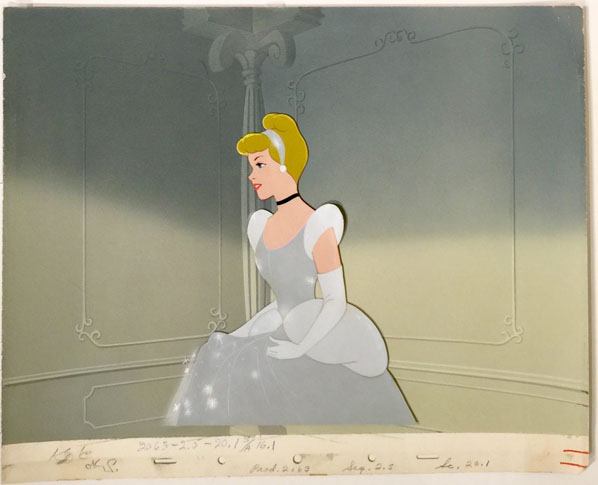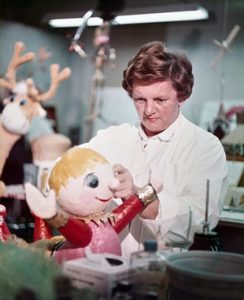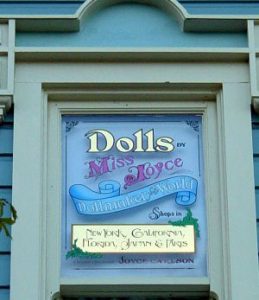Joyce Carlson joined the Walt Disney Studios in 1944 as a “traffic girl” which meant she delivered mail to the various departments among other errands.
She soon transferred to the Ink and Paint department and spent sixteen years inking cels on many of the classic Disney animated features including The Three Caballeros, Victory Through Air Power, Cinderella, Peter Pan, Sleeping Beauty and others.
In 1962, Joyce moved over to Walt Disney Imagineering, then known by the acronym WED, as a model maker for the 1964 World’s Fair pavilions where she worked closely with Mary Blair and Marc Davis on “It’s A Small World”.
For the last years of her life, she was located at Imagineering in Florida which is where I met her and interviewed her in 1998 and 2000 as well as several short conversations in the intervening years. Here is an excerpt:
 Joyce Carlson: A girl I went to high school with moved to Burbank and she worked for Disney and kept saying, “Why don’t you come out to Disney?” I said, “I’m not a cartoonist. I want to do industrial designing. I don’t want to work for Disney”. And my mother kept telling me to work for Disney, and my friend kept pushing me to come on out. She worked in traffic there, and I finally said “okay.”
Joyce Carlson: A girl I went to high school with moved to Burbank and she worked for Disney and kept saying, “Why don’t you come out to Disney?” I said, “I’m not a cartoonist. I want to do industrial designing. I don’t want to work for Disney”. And my mother kept telling me to work for Disney, and my friend kept pushing me to come on out. She worked in traffic there, and I finally said “okay.”
In the main animation building there were four floors. Walt was up on the top. Each floor had its own traffic department. The animators would need pencils, brushes or coffee so we would run down and pick them up and take it to them in their room.
In traffic, you delivered things, ran errands, brought guests up to Walt’s office, delivered mail. That sort of thing. I got into trouble delivering mail because I would drop it right in the big boys’ desks. I went right through the door and dumped it on the desk. I didn’t realize you were supposed to put it up front with the secretaries. So, I didn’t last too long in traffic (laughs). I lasted about six months.
My boss Ben Mosley and his wife, Violet, said “Bring some of your work in. They’re hiring in ink and paint”. She was cockney and I could never quite understand what she was saying. They were running the traffic department.
 So I went home and sketched about six drawings with pen and ink. Ben took my work over to Grace Bailey. I don’t think they’d hire me today if I showed them to you. Grace was just taking Ink and Paint over. Ben took my work over and I guess he put in a good word for me and they decided that maybe I’d be good for inking.
So I went home and sketched about six drawings with pen and ink. Ben took my work over to Grace Bailey. I don’t think they’d hire me today if I showed them to you. Grace was just taking Ink and Paint over. Ben took my work over and I guess he put in a good word for me and they decided that maybe I’d be good for inking.
They trained me for two weeks, and after two weeks they put me on production and we were doing a lot of the war insignias and the shorts for the army and training films. That was fun.
I was never a painter even though I could paint. Inkers did all the line work in pen and ink. You did pen and ink of the characters and mud and water if you were lucky. Yes, because there was a quota and if you were given mud and water that went so quickly that you’d be on top of the average. I was always close to the bottom because they gave me mostly the main characters.
Some of the figures had twelve colors and you had to change your pen points and mix your colors and that took a little time. Sometimes an hour to do just one cel.
You’d call for work and they’d give you six drawings of whatever feature you’re on, like Cinderella. I always seemed to get the main character and as I mentioned there’s about twelve colors on each drawing, each cel. And that’s what takes time.
I had to watch the girl that was before me to ink the line, because there’s a fine line, a medium line, and a heavy line, so you had to follow her lines so it runs smoothly. Otherwise, it’d jump, and that’s what we did. You had to match what the other girls were doing.

We used quill pens. I still got some of my old pen holders and pens, and they still have ink on them. Pushed a pen around for 16 years. No wonder I can’t see so well today (laughs).
We’d get a talking from the boss “You’re not supposed to fraternize with the animators” but we’d go over and see what they were working on. But we’d have fun doing that. We were known as the “nunnery.” All women. Just women.
We had one fella, Lloyd, who punched the cels. (chuckles). He was sort of feminine himself, so he fit in with the girls. But he was the only fella that was in the ink and paint. He was a nice fella; we enjoyed Lloyd.
I had red hair and freckles. I’ve still got the freckles. There was a popular comic strip called Terry and the Pirates and one of the characters was a pilot with freckles. His name was “Hotshot”. If you needed more work, you held up a little sign. One day my supervisor said, “Okay, Hotshot” and that name stuck with me for quite a while. I even had a sign that said “Hot Shot.”
When Xeroxography came in around 1961 they showed me the door. All us inkers left, of course. Grace Bailey asked if I wanted to transfer over to painting and I told her it just wasn’t my cup of tea. But, one thing about inking is you can always get a job on the outside in the ink and paint services.
I used to do that for a little extra money overtime and working Saturdays and Sundays with Celine Miles ink and paint services because studios would all call for the former Disney ink and paint girls and try to get us to do some work when they were pressed on deadlines. I remember one time earning enough so I could take a little trip to San Francisco. Then I ended up at WED working with Rolly Crump and Mary Blair on the 1964 New York World’s Fair.




 Jim Korkis is an internationally respected animation historian who in recent years has devoted his attention to the many worlds of Disney. He was a columnist for a variety of animation magazines. With his former writing partner, John Cawley, he authored several animation related books including The Encyclopedia of Cartoon Superstars, How to Create Animation, Cartoon Confidential and Get Animated’s Animation Art Buyer’s Guide. He taught animation classes at the Disney Institute in Florida as well as instructing classes on acting and animation history for Disney Feature Animation: Florida.
Jim Korkis is an internationally respected animation historian who in recent years has devoted his attention to the many worlds of Disney. He was a columnist for a variety of animation magazines. With his former writing partner, John Cawley, he authored several animation related books including The Encyclopedia of Cartoon Superstars, How to Create Animation, Cartoon Confidential and Get Animated’s Animation Art Buyer’s Guide. He taught animation classes at the Disney Institute in Florida as well as instructing classes on acting and animation history for Disney Feature Animation: Florida.




















































In the interview with Phyllis Craig in your Animation Art Buyer’s Guide, she mentioned that “one of the top inkers ended up at WED working on the Tiki Room and eventually became a supervisor at WED.” She was referring to Joyce Carlson, wasn’t she?
I’m curious as to who exactly decided on the width and colour of the ink lines used in the cels. Was it Grace Bailey, someone else in Ink and Paint, or someone higher up in the Disney organisation like John Hench? Or did it vary with the production? In any case, the fact that Carlson was consistently assigned the most difficult cels to ink, featuring the main characters in the film, says a lot for her talent and the esteem in which she was held by the studio.
I enjoy reading these first-person accounts of life in the Ink and Paint department. It sounds as though it must have been a fun place to work.
You are absolutely correct that Joyce Carlson was the person referred to in the Phyllis Craig interview. Craig was beloved and Carlson was beloved as well. I can attest that even in her later years shortly before her passing, Carlson was still feisty and completely unimpressed with any of her accomplishments. A doll in her image is in the Walt Disney World version of It’s A Small World since she became the Show Quality Standards person for every version of that attraction worldwide.
I don’t know who determined the width of the ink lines. The colors were handmade at Disney and labeled and recorded. Some like “Dreiss Green” for Tinker Bell were created. Dreiss referred to one of the Ink and Paint women who wore a distinctive green dress one day. “Monica Blue” refers to the blue used on the exterior of Disney Cruise Ships and named after an Imagineer named Monica who wore a blue outfit to work one day with just the right elements in the blue.
Cool details to know! Now I’m gonna look for the Hotshot doll on the Small World ride. In Scotland or Ireland, I’m guessing…
The doll is underneath the Eiffel Tower and is wearing Joyce’s trademark big round glasses (similar to the ones Ward Kimball wore later in life). She was the first woman in the Walt Disney Company to reach the 50 and later 55 years of service milestones.
Thanks for the kind comments.
Thanks for shining a spotlight on someone I hadn’t heard about. I absolutely love reading these kinds of interviews.
Also – I love seeing the turtle with the bayonett insignia. I don’t think I’ve ever seen that one.
That, as they say, is show business. When they don’t need you anymore, they won’t even remember ever having needed you. That’s why I’ve always rather hated xerography and CGI animation, because of the all the nice people who worked so hard to get such lovely effects and got unceremoniously dispensed with (without so much as a severance package). And the real losers are the audiences. As I may have remarked once in a while, animation has made the long descent from Tex Avery to tech slavery.
That observation is well worth repeating, Hans.